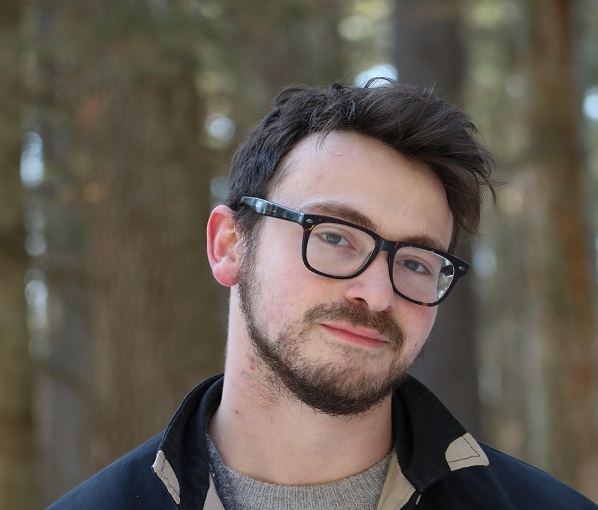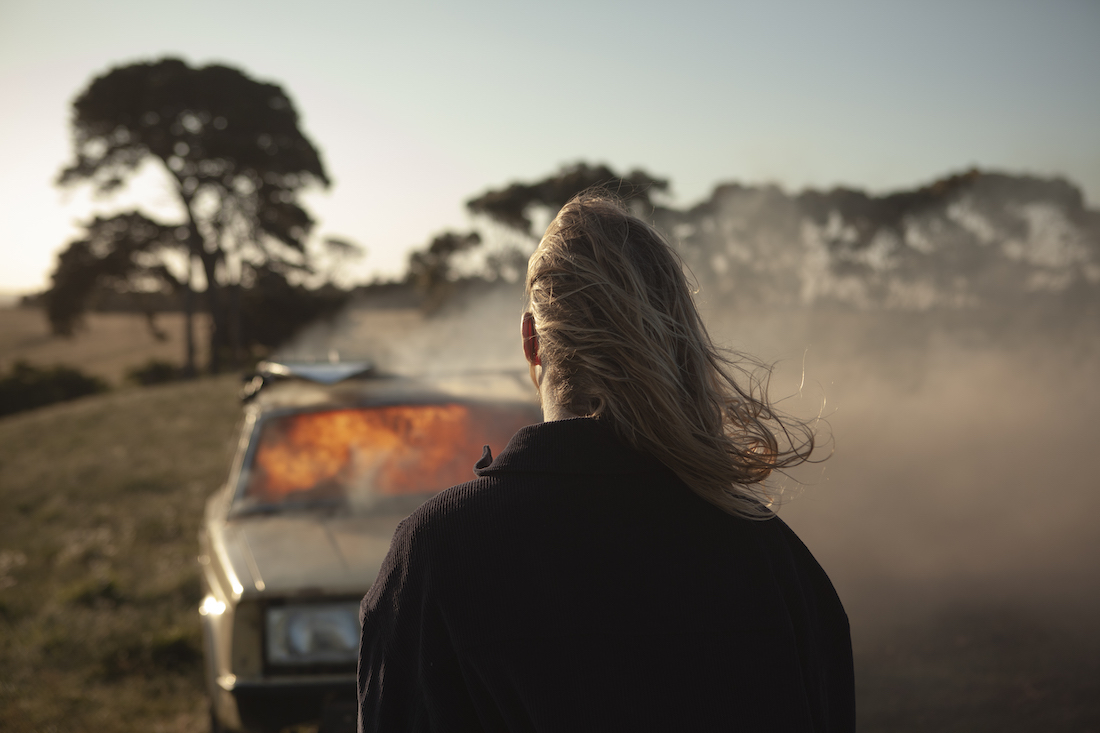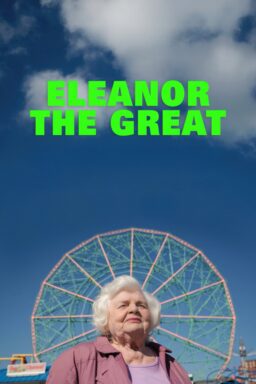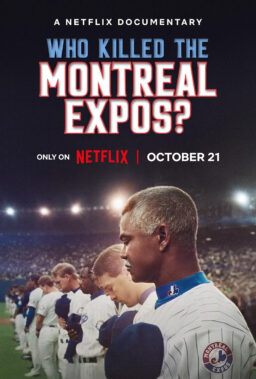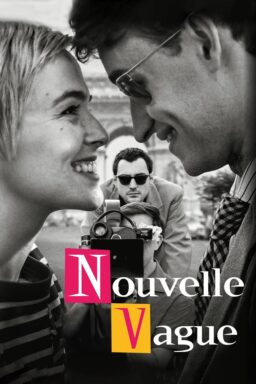Justin Kurzel has never shied away from darkness, but exploring his country’s worst national tragedies on screen is also nothing the Australian filmmaker takes lightly.
“Nitram,” his psychologically pulverizing latest, doesn’t directly depict the 1996 Port Arthur mass shooting, in which a lone gunman killed 35 people and wounded 23 others in a small Tasmanian town. Instead, Kurzel’s slow-burning character drama (out March 30; from IFC Films) shows us the perpetrator’s life beforehand, charting in grim detail the isolation and misery that marked his emotionally stunted adulthood—and the lax gun laws that abetted his eventual turn toward atrocity.
“Nitram” co-stars respected Australian actors such as Judy Davis, Anthony LaPaglia, and Essie Davis (the latter of whom is married to Kurzel), but U.S.-born Caleb Landry Jones portrays the troubled future killer; he’s never named in the film, despite its title spelling out the perpetrator’s first name backwards. This fiercely internalized performance, which won a best actor prize at last year’s Cannes Film Festival, was further lauded by Australia’s equivalent of the Academy Awards, where “Nitram” swept every major category.
It’s been just over a decade since Kurzel brought his feature debut to Cannes, earning a special jury prize at the festival’s Critics’ Week. Set in the same squalid Adelaide suburb where the filmmaker was raised, “The Snowtown Murders” explored the career of serial killer John Bunting from the vantage of an abused teenager, who was first manipulated into seeing Bunting as a role model then made complicit in his crimes. Bleak and disturbing, though too carefully crafted to veer into exploitation, “Snowtown” studied the hard-wired relationship between violence and masculinity, a fascination that Kurzel has furthered across all the films he’s made since: in the fire-and-brimstone poetry of his “Macbeth” adaptation, the generational role-play of “Assassin’s Creed,” and the punk-rock revisionism of “True History of the Kelly Gang.”
But with its nightmarishly tense focus on a young man bound to commit a heinous act, “Nitram” feels most like a return to Kurzel’s roots. Like “Snowtown,” it began as a script by Australian writer Shaun Grant, who sought to tell a story from a real mass shooter’s perspective in order to stress the need for gun reform. When Grant brought “Nitram” to Kurzel, the filmmaker was in need of work; the difficulties of filming during the pandemic had disrupted a previously planned project. “Nitram” registered to both as the kind of small-scale production they might be able to get made at that time. Financing challenges, in part owing to the controversy “Nitram” had stoked in Australia before a single frame was shot, further limited its budget.
During the four-week shoot in Geelong, near Melbourne, the 60-person cast and crew lived and worked in a bubble, which Kurzel says contributed to the project’s contained, intimate tenor. With “Nitram” out this week, Kurzel spoke via Zoom about working with Jones and analyzing the ancestral violence of his homeland.

“Nitram” examines a painful chapter in Australian history; the film proved controversial there in some quarters as soon as news broke that you were making it. Holding Shaun Grant’s script in your hands, how did you feel about the challenges of respecting such sensitive material?
It was terrifying, really. The shootings happened in Tasmania—my wife, Essie, who’s in the film, is Tasmanian, and we live in Tasmania now—and it was a seismic event in Australia. Everyone knew where they were when the shootings happened. As I was reading “Nitram,” I knew that it had better be right, the way it was conceived and written; otherwise, it was going to be too hard to do.
But I thought there was an authenticity as to why Shaun was writing it. He’d been living in Los Angeles and come quite close to a shooting that had happened just up the road. In a fever, he started writing what was, at the beginning, an anti-gun film. And he’d found a way in which he wanted to tell that story through this particular character, allowing an audience to understand that, when he walks into that gun store, there’s just no way this person should be able to get those weapons so easily. For him, that scene was always, probably the most important.
Over time, it developed into a film about family and about isolation, about outliers and what our responsibility is as a society to those people that are around us. This particular person, in Tasmania, was very visible. He was around a lot of people, who have a lot of memories of him. It wasn’t as if he was cut off from society. I knew—even when we had people not wanting the film made in Australia and especially in Tasmania—that there had also been a real curiosity, 25 years later, as to how and why this event happened: what changed in terms of the gun laws and reform in Australia, but also people wanting to just understand more why it happened.
Your work often explores masculine violence, but making a film about a mass shooter runs that particular risk of aggrandizing a perpetrator or securing their place in history. How did you approach that tension of making a movie about this individual without in some way mythologizing them?
It’s a really tricky thing. It was always on the forefront of our minds: that question of how much empathy you bring to a character who commits, at the end of the film, a most horrific act. I found in Shaun’s script that there was something really familiar and recognizable about the family, the world, and this character. He’d found a way, especially in the first half of the film, to make you think you’ve walked past that person before, that you had perhaps been to school with them, or seen them bullied, or seen them bully someone. There was something incredibly recognizable about it.
That’s what I found intriguing. It wasn’t written as this one-dimensional monster story. It was questioning the people around him, the choices that he was making, his upbringing, his mental illness, and also the failing of a system at that time in Australia, that allowed an individual at his most dangerous and his most isolated to have access to that weaponry. In Australia, it’s shocking, because we’re just not surrounded by guns, like you are in America. It’s a very different conversation, and that conversation changed dramatically after these events. The legacy of it, 25 years later, is still really raw and fresh. And it’s now a time in Australia when some of these gun laws have been petitioned to be weakened. We felt that the timing of it was important, in terms of revisiting the event.
Atmospherically, “Nitram” feels like it exists outside of a specific time and place; there’s this desolate, eerie quality to its world as well. What did you want to capture in terms of the film’s setting?
There’s definitely a kind of suburbia going on there. The Snowtown murders happened around 1995 and 1996 as well, and the shootings happened in 1996 in Tasmania. The film is definitely putting a lens up to a particular suburban world. In “Snowtown,” it was more disenfranchised, and there was a reflection about class and those in need, how they can become easily exploited by someone like John Bunting. “Nitram” was much more about middle Australia, about growing up in the suburbs.
That question about masculinity in “Snowtown” is also in this film. If you’re not part of a tribe, and one of those blonde Australian surfers who are very iconic here… If you’re not part of those very physical, alpha-male groups in Australia, it can be really distancing. This film is definitely a questioning of male culture in Australia, how inclusive it is and what happens if you are an outlier of that, if you can’t find your tribe that you belong to. It was definitely something Shaun and I were continuing in terms of the discussion about that aspect of our culture—which is everywhere, as well, and every culture has its own tribes. If you’re not part of those tribes, what are you?

In “Snowtown,” John Bunting has this line, justifying brutality, where he says, “It’s an Australian f**kin’ tradition, isn’t it?” In making films about mythologies of masculine violence as you have, what do you consider to be specifically Australian about that idea?
I think it’s an incredibly violent place, and very brutal. It has been in the past. The settlement of Australia, and the genocide of the indigenous peoples, has been something that white Australia finds very difficult to talk about: to have a reckoning with, to apologize, and to be able to have a conversation about. There are events throughout history, in Australia, that have been really dark chapters. But, for some reason, we’ve just had this inability to be able to look at the truth.
It’s a hard place to live, and that settlement is pretty young. I think violence has always been a backdrop, especially within men in Australia, that I’ve been interested in. When I was younger, I was surrounded by communities that did have violence in them, like Snowtown, which is where I grew up. I’m curious about its roots and why, in this particular place, it is what it is. I’m curious about how these events manifest and the fact that they become a boil that needs to be lanced.
“Nitram” is no exception, and it has been very difficult for people to have a conversation about it. When it was announced that we were making it, the Prime Minister of Australia talked about it at Question Time the day it was found out that we were making it. Right from the very top, it’s a subject matter that was difficult; I understand it from the point of view of those who were affected by it. But I’m also curious as to why, 25 years later, we can’t through art discuss it in ways that allow us to understand what goes on in the shadows of our history.
Your brother, Jed Kurzel, scores many of your films; his work in “Nitram” is subtle but ominous. It’s an unsettling contrast to the Gilbert and Sullivan show tunes that Essie Davis’ character, Helen, brings into the narrative. Both in terms of sonic and visual elements, what can you tell me about stylization as a tool for seeing more about a subject than you could if you were approaching them straight on?
“Nitram” was a connection back to that balance between trying to create authentic social dramas—where you’re using real locations and real people at times to perform, trying to depict something on screen that you believe in—and this cinematic point of view of a lead character, how you can put a lens to that point of view.
In “Snowtown” and “Nitram,” especially, it’s been a real investigation into how those two styles can work, play next to, and complement each other. I really enjoy that world, stylistically. And that’s very different from “True History,” “Macbeth,” and “Assassin’s Creed,” in that they are styled with very specific, strong worlds, whereas “Snowtown” and “Nitram” have always been about leaning on something that’s real, trying to take an audience and convince them into a place and a moment in time—into a group of people in a community, as well—while finding a cinematic point of view.
That’s where Jed has become really important in my work. At times, within those real worlds, [the score] allows you to focus in on a voice or a view. With “Nitram,” I found the whole world of Gilbert and Sullivan fascinating: these show tunes that were part of Helen’s life and that were introduced to this boy who had no culture or art around him, and how those sounds and their worlds could start to break down and dismantle. I was also fascinated by lawnmowers, birds, and cars off in the distance. What are the sounds of suburbia that are comforting but at the same time could drive you crazy?
That was probably more what I was interested in doing with this film than creating a musical point of view that was his, [meaning Nitram’s.] Anytime we placed music on and around him, it felt like that really dangerous thing where you’re forcing an audience to feel something towards the character. This film was much more about having distance and being more nuanced about how we wanted an audience to feel towards him. If you went to one [musical cue] or the other, it started to feel as if you were placing some sort of judgment on the character. It was really interesting, this film. It wanted some oxygen and breath around it, as opposed to being so cinematically led.

Terrified as I was by him, I couldn’t take my eyes off Caleb Landry Jones in this film. His work is crucial to that balance of empathy and immersion we’re discussing. What was it like working with him to determine how you wanted this character to feel on screen?
Right from the beginning, Shaun and I kept thinking about Caleb. We’d only really known him from two or three films, but there’s a quality about him that’s always so watchable. It’s a very unusual film to give to an American, but he had such great instincts and insights, and he’s very immersive. He’s a Method actor. He lives and breathes it. He doesn’t have a switch-off button, so it’s incredibly exhausting and all-consuming for him.
To get that Australian accent, as well, is pretty hard. Not many have been able to do it. And especially for an American Texan to be able to pull it off… The British have a much easier connection to the accent, but it’s harder for Americans to do. The biggest compliment is that he won the Best Actor prize at our Academy Awards; Australians are very critical of others doing Australian accents, so he was pretty extraordinary in that sense.
In terms of his approach, it was that fine balance of never wanting any of the scenes to scream what was coming at the end, and at the same time not wanting to lull the audience into having so much empathy for the character that we’d somehow be forgiving what he was about to do. It was always this real balance between “I recognize that person, and that feels familiar” and “That person is completely, cataclysmically dangerous.” We would do two to three takes, and there was always one take there that was the opposite in tone; one take might feel calm and comfortable, and then the next take might just have a sense of danger to it. That was important for calibrating the character in the edit; at times, if I felt that he was screaming “dangerous” too soon, I could find something Caleb had done that was much softer.
Caleb was able to understand that and provide those different shades. I’ve never worked with an actor before who dove into something so wholly. A lot of actors talk about living and breathing something but, really, there’s a turn-off button at the end of the take, at night, in the morning. I can understand that. You can’t always do it. But he was pretty much on, always. He was living it, always. And I found that to be very inspiring. He loves acting. And I know that sounds simple to say, but that is rare, when you see that an actor’s in it because they absolutely love acting. They don’t give a f**k about fame or give a shit what their next role is. They’re completely and utterly present in the moment of what they’re doing, there and then. He’s one of those.
Two Australian cinematographers were Oscar-nominated this year: Greig Fraser, who won for his work on “Dune,” and Ari Wegner, who was nominated for “The Power of the Dog.” You’ve worked especially closely with Wegner, who shot “True History of the Kelly Gang.” What can you tell me about your collaboration with her?
I mean, she’s fantastic. I’ve really known Ari since film school, so to see her nominated along with Greig Fraser, whom I worked with in my younger days, it’s an amazing thing. Probably out of all the practitioners, the number of successful cinematographers coming out of Australia is quite extraordinary. I don’t know what it is. Maybe it has to do with the landscape and the light there, a particular kind of connection that those cinematographers have with their craft. Ari has had to wait a long time for people to really see her. And she’s been working really, really hard for a long time. So to see the respect that she’s getting at the moment is really heartening, because I really know how hard it has been for her. The timing of her work is just perfect, for people to understand and see how brilliant she’s been for a very long time.
Last question. Your next project, “Morning,” has Laura Dern, Benedict Cumberbatch, and Noah Jupe set to star. It’s science-fiction, and given that “Assassin’s Creed” played in that genre space, I was curious what led you back there, and whether you think in terms of genre when considering projects.
Usually, with genre, there’s a bent to it. There’s always something about it that is going against or exploiting the genre. “Morning” is a film set in a time where there’s no sleep, and it’s definitely got these sci-fi and futuristic elements to it but, essentially, at its core, is this beautiful little family drama between a mother and son. The best sci-fi films that I’ve ever loved have been about something really simple, something much smaller than the grandness and largeness of the concept around it. That’s probably what I’ve been most attracted to. I haven’t set out to make anything in a genre. It’s really just been the scripts that have come my way.
“Nitram” is now playing in theaters, and available on AMC+ and for digital rental.
